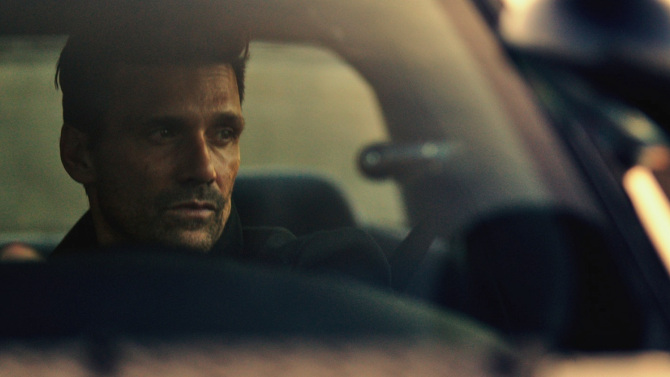The title may imply heightened scope and stakes, but only the premise is out of order in “The Purge: Anarchy,” a swiftly delivered, surprise-free sequel to 2013′s economical sleeper hit. Moving out of the home and into the streets, writer-helmer James DeMonaco’s noisy follow-up shifts genre gears slightly, largely abandoning domestic-invasion horror for an urban-thriller template that notionally expands on the first film’s sketchy class satire. Success, however, has bred self-seriousness in this probable franchise, as “Anarchy” uses an expanded running time to pontificate emptily on the sociopolitical implications of its still-ludicrous allegorical setup — a future America in which all crime is legalized for one night a year — at the expense of any whopping B-movie jolts. Nevertheless, considering the scarcity of comparable genre fare in theaters, plus the first film’s growing profile in ancillary, this nasty annual event is probably good for at least one more year.
Interestingly, “The Purge” opened tepidly in Blighty before landing with a bigger bang in the U.S., where the home audience evidently found its Occupy-era state-of-the-nation subtext more resonant — at least to the tune of $64 million, a figure 20 times larger than its budget. From that outcome, DeMonaco and his producers (who still include Michael Bay and “Paranormal Activity” enabler Jason Blum) have smartly concluded that the original’s high concept was what drew crowds, and have upped the America-centric social panic in the new film’s script. The purse strings, meanwhile, appear to remain tight, as befits a film that superficially opposes One Percent excess. The first film’s moderate star power, for one thing, has been dimmed further: Only one member of the original ensemble (led by Ethan Hawke, a casualty of the previous Purge) remains, while fine character actors Frank Grillo and Carmen Ejogo take the lead.
That concept, however, remains as much a sticking point as it is a selling point — suitable for lurid exploitation fare, but undermining the credibility of DeMonaco’s creation as the extreme social tract it clearly wishes to be. The notion that even the most irresponsibly right-wing American government would sanction an annual bout of mass public carnage is so patently absurd, particularly without any surrounding dystopian context in the “Hunger Games” vein, that “Anarchy” seems unlikely to sound a chord of genuine alarm in most viewers. Likewise, the intended moral debates set up by this nightmare scenario (which here include the eye-for-an-eye vigilantism of a grieving parent) seem similarly facile in a narrative built on such distant hypotheticals. There are cinders here of the reactionary political curiosity that burned through Christopher Nolan’s “Dark Knight” films, but the real-world parallels are dubious at best.
Rather than focusing on one domestic unit affected by the Purge — now in its sixth year, we are told — DeMonaco divides his attention among five characters, some more carefully etched than others. The most convincing and sympathetic of them are hard-up single mother Eva (Ejogo) and her teenage daughter, Cali (Zoe Soul, one to watch), whose plans for quietly surviving the night indoors take a grim turn when they discover that Eva’s elderly father has sold his life to an organization that arranges private Purging parties for the wealthy — a grotesque extension of the film’s argument that the Purge was initiated in the interests of redistributing wealth upward.
When Eva and Cali are captured by a masked gang of Purgers, it’s left to enigmatic lone-wolf gunman Leo (Grillo) to rescue the women and shepherd them to safety through the death-ridden streets of Los Angeles. Leo, as we already know and Eva eventually surmises, is a police sergeant out for revenge against those responsible for his young son’s recent death. The trio are joined in their long night’s journey into day by a stranded, bickering couple (Zach Gilford and Kiele Sanchez) who have been tormented by the same ominous gang, and seem sufficiently indistinct in their characterization to be an easy bet for first-casualty pundits.
Quite why these particular individuals have been targeted is never explained in the script; that they wind up in the same car is a handy dramatic convenience. It is refreshing, however, to see DeMonaco flip the demographic focus from the first film: While a privileged white family took centerstage there, here it’s a pair of working-class African-American women who are presented as the audience’s primary point of identification, further enabled by the wonderful Ejogo’s weathered warmth and quiet intelligence, qualities that shine through an underwritten, increasingly passive role. The background presence of a group of militant black anti-Purgers led by charismatic intellectual Carmelo (Michael K. Williams) makes further gestures toward an expanded cultural outlook for the franchise, though allusions to the Black Panther Party don’t extend beyond the cosmetic.
For all the philosophical and metaphorical shortcomings of his script, however, DeMonaco is an efficient orchestrator of action. Working once more with cinematographer Jacques Jouffret (who shoots the City of Angels with a grainy, gold-flecked sheen that recalls Paul Haggis’ oddly, indirectly comparable “Crash”), DeMonaco keeps the proceedings at a consistently discomfiting level of tension, even if the film’s arsenal of shocks is as limited as its weaponry is shudderingly diverse. Of particular note in the technical department is the sound team, including veteran mixer Willie Burton, whose rattling panoply of shrieks, sirens and gunfire deliver more than the film itself on the chaos front.

